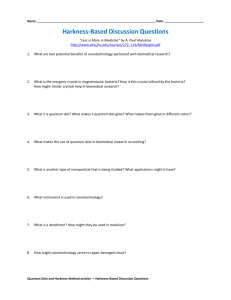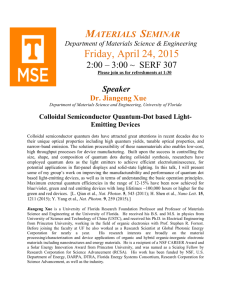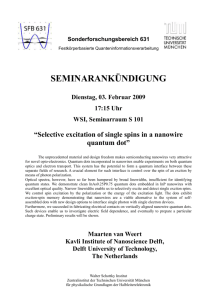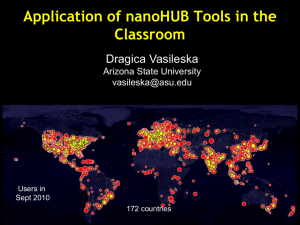Slides - nanoHUB
advertisement
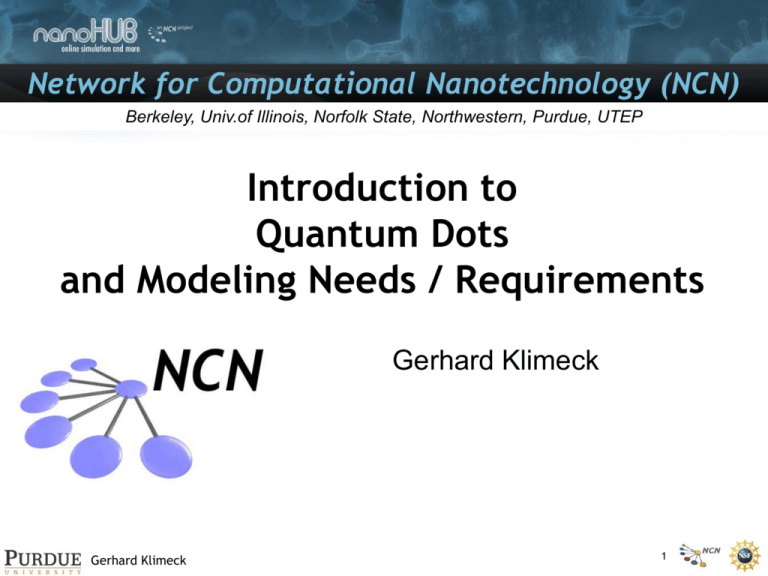
Network for Computational Nanotechnology (NCN) Berkeley, Univ.of Illinois, Norfolk State, Northwestern, Purdue, UTEP Introduction to Quantum Dots and Modeling Needs / Requirements Gerhard Klimeck Gerhard Klimeck 1 What are Quantum Dots? “Man-made nanoscale structure in which electrons can be confined in all 3 dimensions” Atom Small Dye Molecule Fluorescent Protein Bulk InAs GaAs Eg, GaAsD(E) 1Ao 1nm 10nm Animal CellQuantum Dot Bacterium Quantum Well Quantum Wire GaAs D(E) D(E) 1um 10um E E Eg, InAs 100nm D(E) 100um E E Quantum Dot Quantum Dots are larger than atoms 3-dimensional Confinement Discrete Energy levels “Artificial Atoms” Band gap Difference Low energy potential wells Hole and Electron Confinement Gerhard Klimeck Muhammad Usman 2 What is a Quantum Dot ? Basic Application Mechanisms Physical Structure: • Well conducting / low energy domain surrounded in all 3 dim. by low conducting / high energy region(s) • Domain size on the nanometer scale Electronic structure: • Electron energy may be quantized -> artificial atoms (coupled QD->molecule) • Contains a countable number of electrons Photon Absorption Photon Emission Tunneling/Transport Occupancy of states Detectors/ Input Lasers/ Output Logic / Memory Quantum dots are artificial atoms that can be custom designed for a variety of applications Gerhard Klimeck QD Example Implementations Self-assembled , InGaAs on GaAs. Colloidal, CdSe, ZnSe Pyramidal or dome shaped R.Leon,JPL(1998) http://www.research.ibm.com/journal/rd/451 Electrostatic Gates, GaAs, Si, Ge Create electron puddles Source: http://www.spectrum.ieee.org/WEBONLY/wonews/aug04/0804ndot.html Fluorescence induced by exposure to ultraviolet light in vials containing various sized cadmium selenide (CdSe) quantum dots. Source: http://en.wikipedia.org/wiki/Fluorescent ß Gerhard Klimeck Quantum Dot Applications • Memory: Store discrete charge in potential wells. • Transistors: Use discreteness of channel conduction. • Logic: Use electrostatically coupled quantum dots. Lent, Porod @ Notre Dame: Quantum Cellular automata, electrostatically coupled quantum dots. Chou @ Princeton Room Temp. Single Electron Memory Hitachi: 128Mbit Integration demonstrated Gerhard Klimeck Harris @ Stanford: Room temperature single electron transistor Quantum Dot Applications 2 • Medical Markers: Inject body with optical markers that are attached / adsorbed to particular tissue • Quantum Computing: Process coherent states of charge, spin, or optical interactions • Infrared Detectors: Can absorb light at all angles QDs for Quantum Computing Gerhard Klimeck Colloidal Dots can be used as implantet optical markers Quantum Dots: Absorption has weak incidence angle dependence Quantum Dots as Optical Detectors • Problem: Quantum wells are “ blind” to light impinging orthogonal to the detector surface. • Standard Solution: Need gratings to turn the light • New Approach: Quantum dots have a built-in anisotropy and state quantization in all three dimensions -> absorption at all angles Quantum Wells: Absorption has strong incidence angle dependence Electromagnetic Modeling Standard Solution: electric field models Grating optimized light coupling Gerhard Klimeck Quantum Dots: Absorption has weak incidence angle dependence Lighting • Quantum-dot LEDs » Seem to be key to advances in the fields of full-color, flat-panel displays and backlighting • QD emits a color based on its size » Smaller dots emit shorter wavelengths, such as blue, which, in the past, has been difficult to attain » Larger dots emit longer wavelengths, like red Gerhard Klimeck Fluorescence induced by exposure to ultraviolet light in vials containing various sized cadmium selenide (CdSe) quantum dots. Source: http://en.wikipedia.org/wiki/Fluorescent Some more Quantum Dot Applications Room Temperature Lasers Infrared Photo-detector Fujitsu Temperature Independent QD laser 2004 S. J. Xu Dept. of Physics , University of Hong Kong (2005) Quantum Gates Gerhard Klimeck Muhammad Usman Quantum Dots Fluorescence Imaging Sources: http://vortex.tn.tudelft.nl/grkouwen/qdotsite.html http://www.whitaker.org/news/nie2.html 9 Quantum Dots and Single Electronics Moore’s Law (loosely formulated): • Overall device performance doubles every 18 months • Historically true for over 20 years • Technically achieved by • Making device features ever smaller => devices become faster • Making wafer ever larger => reducing or maintainig the overall cost per chip 0 SIA Roadmap 10 -1 10 -2 2-D Lithography feature 1-D feature 5-100 Å CMOS Devices DRAM CMOS Devices with Quantum Effects Quantum Devices -3 10 1980 1990 2000 Year 2010 Gerhard Klimeck e2 kT >> 2C Growth Minimum Feature Size (µm) 10 2020 kT << e2 2C How can Quantum Dot Modeling Help? • Why Theory, Modeling and Computation? • Quantum dots grow in different shapes and sizes • PL intensity is measured to determine light spectrum • Experimentalists needs to understand the PL spectrum Experiment AFM micrograph of InAs QD Diagnostic data Missing Physics Source: cqd.eecs.northwestern. edu/research/qdots.ph p Applied Phys. Lett. 78, 3469 (2001) Modeling can provide essential insight into the physical data Obtain information where experimental data is not readily available Can help experimentalists to design their experiments Muhammad Usman Gerhard Klimeck Simulation Comparison 11 What is required in a good model for quantum dots? • Realistic Size Strain domain ~ 10-15 million atoms, Electronic domain ~ 5-10 million atoms • Interface roughness • Alloy randomness InAs bulk E(k) relation (www.nanoHUB.org) • Long range strain • Non-parabolic dispersion • Piezoelectricity GaAs CB HH - LH SO GaAs buffer Gerhard Klimeck Muhammad Usman InGaAs Acknowledgement: Insoo Woo (Purdue Univ) Biaxial Strain InAs Dome QD InAs 40nm Strain Yes Piezo No Strain Yes Piezo 12 Yes Quantum dot modeling : What is out there ?(1) Single-band Effective mass model Multi-band Effective mass model or k•p method Method Individual Hamiltonians for electrons and holes: 2 H e = − * ∆ + Ve (r ) + E g 2me 2 H h = − * ∆ + Vh (r ) 2mh Pseudo-potential Method Tight Binding Model me* and mh* are effective masses More bands can be added and couplings between the bands can be allowed (CB, HH, LH, SO). Draw Back • parabolic dispersion E(k) assumption. 8-band k•p method: coupling between conduction and valence bands • Ignore Interface roughness, alloy randomness References: • Can not capture atomistic symmetry, optical anisotropy of p-states Gerhard Klimeck Muhammad Usman 1. 2. 3. D. Bimberg C. Pryor P. Hawrylak O. Stier et al., PRB 59, 5688 13 (1999) C. Pryor et al., PRB 57, 7190 (1998) Quantum dot Modeling :What is out there? (2) Single-band Effective mass model Multi-band Effective mass model or k•p method Method • Potential of ions and core electrons is replaced by “pseudopotential”. • Plane wave basis states: Pseudo-potential Method H pp Tight Binding Model 2 =− ∆ + ∑ V pp (r − Ri ) 2m i ψ pp = ∑ ck eikr k Draw Back • Computationally expensive Hard to simulate realistic device sizes Gerhard Klimeck Muhammad Usman Pseudopotential is decided atomistically on the basis of atom locations Atomistic representation References: 1. Alex Zunger A. Zunger, Phys. Status Solidi B 224, 727 (2001) 14 Quantum dot modeling : what is out there? (3) Single-band Effective mass model Multi-band Effective mass model or k•p method Pseudo-potential Method Tight Binding Model Hamiltonian in terms of linear combination of atomic orbitals: ψ (r ) = ∑ atomic site, i orbitals, α Ciα= coefficients, φiα= atomic orbitals (s, p, d, s*) H iα , jβ = φiα H φ jβ = iα H jβ = ∫ drφ β* (r − R j )Hφα (r − Ri ) • Atomistic details On-site and coupling matrix elements are calculated empirically by matching experimentally found band gaps, effective masses etc • Computationally less expensive Reference: • Correct band mixing 1.Boykin, Klimeck • Band structure over entire Brillouin zone 2.Jean-Marc Jancu Why Tight Binding? Gerhard Klimeck Muhammad Usman ∑ Ciα φiα (r + R i ) φ= orbital(s, p, d, s*) G. Klimeck et al., CMES (2004), Vol.3 no. 5, pp601-642 Ciα Ψ 15



